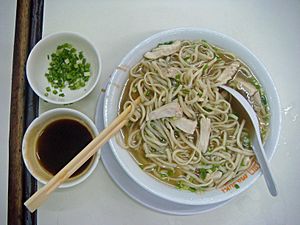Filipino Chinese cuisine facts for kids
Filipino Chinese cuisine is a yummy mix of Filipino cuisine and Chinese cooking. It's like two great food traditions coming together to create something new and delicious!
Contents
How Filipino Chinese Food Began
Filipino food has been shaped by many cultures. The main influences are from China and Spain. These ideas blended with the traditional cooking styles of the Philippines before other countries arrived.
Trade between the Philippines and China began a long time ago. Records show it started in the 11th century. But some think it might have begun even earlier. For example, old pottery found in Laguna province dates back to the Tang dynasty (AD 618 - 907).
Chinese traders brought silk to the Philippines. This silk was then sent to Mexico and Spain on the Manila galleon trade ships. In return, the Chinese took products from the Philippines. These included things like beeswax, rattan, and even sea creatures like beche de mer.
Chinese Words in Filipino Food
It's easy to see Chinese influence in Filipino food. Many food names are a big clue!
Take Pansit, for example. These are noodles cooked with seafood, meat, or vegetables. The word pansit comes from the Hokkien Chinese words piān-ê-si̍t. This means something that is "conveniently cooked."
Today, pansit isn't just stir-fried noodles. It also includes noodles shaken in hot water with sauce, like pansit luglog. Or noodles served in broth, like mami and lomi. The word can even mean food not shaped like noodles. An example is pansit molo, which are pork-filled wontons in soup.
Early Chinese traders might have made noodles in the Philippines. They would have used local ingredients. Over time, different towns created their own versions. For instance, Malabon, a fishing town, made pansit Malabon. This dish uses oyster, shrimp, and squid. But in Lucban, Quezon, far from the sea, they have pansit Lucban. This one is made with meat and vegetables.
Another example is lumpia. This is like a Chinese eggroll that became a big part of Filipino food. Even its name, lumpiang Shanghai, shows its Chinese roots. Wrapping meat or vegetables in an edible wrapper is a Chinese cooking trick. You can find it in many parts of Southeast Asia. The Filipino version can have meat, fish, or vegetables. It can be served fresh, fried, or even plain.
More Chinese Influences
The Chinese influence goes deep into Filipino cooking. It's not just about food names or restaurant dishes. The use of soy sauce and other soybean products is Chinese. These include tokwa, tahuri, miso, tausi, and taho. Many vegetables also have Chinese roots. Examples are petsay (Chinese cabbage), toge (mung bean sprouts), and mustasa (pickled mustard greens).
Even some cooking tools still have their original Chinese names. The sian-se is a turner. The Filipino carajay (a Spanish spelling) is actually the Chinese wok.
Chinese cooking methods also influenced Filipino Chinese cuisine. Pesa is a Hokkien word meaning "plain boiled." It was first used for cooking fish. In Tagalog, it can mean both fish (pesang dalag) and chicken (pesang manok). Dishes like pa ta tim and pa to tim use a Chinese braising technique called tīm.
Most early Chinese traders came from the Fujian province. Because of this, Fujian/Hokkien food had the biggest influence. However, many Chinese restaurants in the Philippines also serve Cantonese food. This is because Cantonese food is often popular in restaurants. Other Chinese food styles are available too, but they are less common.
When the Spanish arrived, they brought their own food influences. These came from both Spain and Mexico. Chinese food became a main dish in panciterias (noodle houses) in the 19th century. These dishes were often given Spanish names. "Comida China" (Spanish for "Chinese food") includes arroz caldo (rice and chicken porridge) and morisqueta tostada (fried rice).
Popular Filipino Dishes from Chinese Cuisine
Here are some popular Filipino dishes that came from Chinese cooking:
- Batchoy (Chinese: 肉脆)
- Hopia (Chinese: 好餅)
- Kiampong (Chinese: 鹹飯) - a type of fried rice.
- Kikiam (Chinese: 雞捲)
- Kwapau (cuapao) (Chinese: 割包)
- Lomi (Chinese: 撈麵)
- Lumpia (Chinese: 潤餅) - like a spring roll.
- Machang (Chinese: 肉粽) - a sticky rice dumpling.
- Maki mi (Chinese: 肉羹) - meat in a thick soup.
- Mami (Chinese: 馬麵/肉麵) - a noodle soup created by Ma Mon Luk.
- Pancit (Chinese: 便食) - a variety of noodle dishes.
- Siomai (Chinese: 燒賣) - steamed dumplings.
- Siopao (Chinese: 燒包) - steamed buns with filling.
- Taho (Chinese: 豆花) - a sweet tofu dessert.
- Goto (Chinese: 牛肚) - rice porridge with ox tripe.
- Pork Tito (Chinese: 豬肚)
- Bicho-Bicho (Chinese: 米棗) / Shakoy (Chinese: 油炸粿) - a fried dough snack.
- Tikoy (Chinese: 甜粿) - a sticky rice cake.


